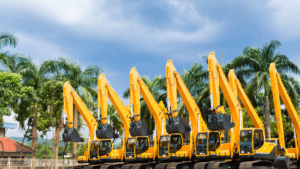In construction, where deadlines are tight and projects are complex, the efficient management of machinery and tools stands as an important practice that can take your business to whole new heights.
Whether you’re overseeing a bustling construction site or managing a fleet of heavy machinery, the impact of properly allocated and maintained equipment simply cannot be denied.
But, if you’re still questioning what exactly good equipment management can do for your business, this article is for you.
Read on, and you’ll discover the multitude of benefits of this essential aspect of business operations, as well as learn how to enhance your own equipment management strategy.
In this article...
Easier Equipment Tracking
Equipment management typically involves implementing some kind of asset tracking method, such as Bluetooth, RFID, GPS, or other monitoring technologies to keep tabs on valuable machinery and tools.
The usual setup for these systems entails attaching a tracking device to assets and using software to monitor their locations in real time.
Below, you can see how GPS fleet monitoring works.

Yet, the significance of machine and tool tracking goes beyond just knowing where your equipment is; it provides insights into its users and usage patterns.
This complete visibility and control of your assets bring about numerous advantages.
For example, if your workers tend to hoard machinery, you can proactively address the issue by promptly identifying idle machines and tools at job sites and then adjusting your equipment allocation accordingly.
The problem of employees spending large portions of their working hours searching for tools also becomes a thing of the past, as the missing items can now be easily located on a digital map.

In short, tracking eliminates situations that waste your time and empowers you to focus on what really matters—getting the work done.
But the benefits extend to security as well.
Namely, these monitoring tools act as a deterrent against theft, since tracking devices signal to the thieves that equipment is being monitored.
Even if theft does occur, they offer insight into the last known location, which then aids in stolen asset recovery.
All in all, using some form of tracking technology is indispensable for those aiming at successful asset management.
It not only safeguards your equipment but elevates overall operational efficiency, too.
After all, when it comes to effective management, it’s all about being a step ahead, addressing issues before they arise, and saving time—your most precious resource—for the battles that truly matter.
Equipment tracking enables you to do just that.
Reduced Repair Costs
Proper equipment management is not only a time-saver—it can also translate into significant cost savings.
Provided you establish an efficient maintenance regime, that is.
In the simplest of terms, without adequate maintenance, your assets become far more susceptible to some big (and costly) issues.
And remember, repair costs extend beyond mere materials and equipment parts.

Instead, they encompass hidden profitability killers such as unplanned downtime, project delays, and reduced asset lifespans, all of which can adversely impact your company’s financial health in the long run.
So, what does an efficient maintenance regime even mean?
Simply fixing your machines and tools when they break actually increases the frequency of breakdowns, leading to higher repair costs as well as shortening their service lives.
Therefore, if this is your current strategy, it may be time to reconsider.
Preventive maintenance, for example, is definitely an option worth exploring.
It involves performing smaller repairs and inspections more regularly to nip minor issues in the bud before they turn into equipment failure or any other major, project-halting problems in the future.
In fact, research has shown that this proactive approach significantly reduces unexpected downtime and defects, resulting in substantial long-term savings on repairs.

Now, although implementing preventive maintenance is a necessary practice, there’s no denying it can sometimes be challenging.
After all, it requires planning and diligent maintenance log tracking, demanding considerable time and effort.
Fortunately, GoCodes Asset Tracking makes this process much more manageable.
With the Tasks feature, which is a part of our asset management solution, you can set up tasks, assign them to specific workers, and monitor their progress.
In other words, this feature makes the organization of everyone’s responsibilities a breeze.

No more missed oil and filter changes—the entire team stays on top of their tasks, propelling your maintenance game to a whole new level.
Moreover, the software also sends scheduled service notifications, either on the day of or the day before maintenance, depending on your settings, to remind everyone of their assignments.
Essentially, with GoCodes Asset Tracking, your equipment stays well-maintained, and repair expenses remain low, no matter what.
At the end of the day, your machinery isn’t supposed to be just a strain on your finances, but a strategic asset that propels your business towards success.
Improved Productivity
It goes without saying that the ability to complete tasks within a certain time frame holds paramount importance in construction.
In fact, timely project completion is not just a goal; it is a prerequisite for survival in this competitive industry.
This is yet another reason why poorly maintained tools and machines inevitably invite trouble.
Just picture this scenario: you’re in the midst of an important project, and all of a sudden, a key piece of equipment malfunctions.
Cue the chaos.
Unfortunately, the ATS State of Industrial Maintenance report shows that productivity is mainly affected by precisely that—equipment breaking down.

This report identifies unplanned downtime due to asset failure as the number one productivity killer, surpassing even the impact of a shortage of skilled workforce.
When machinery suddenly breaks down, pretty much everything has to stop.
Workers cannot continue with their work, the problem with the broken piece of equipment first has to be analyzed and then repaired or, if the issue is unfixable, a replacement needs to be found.
And it needs to be found quickly.
The stress caused by such situations is palpable, but the true cost of decreased productivity is staggering.

According to Siemens’ research, in 2022, Fortune Global 500 companies incurred a cost equivalent to 11% of their annual turnover, totaling almost $1.5 trillion.
But this isn’t just a big-business problem.
Sure, you might not lose billions upon billions like these companies, but the consequences of poor equipment management are just as real for smaller businesses.
Implementing a robust maintenance regime as a part of your management strategy, therefore, emerges as a vital approach for mitigating these consequences and enhancing overall productivity.
Whether a large corporation or a small enterprise, your equipment needs to be a reliable teammate, and not a wildcard.
That’s why treating it right is the key to smoother operations, increased efficiency, and, ultimately, success.
Enhanced Construction Site Safety
Everyone knows that working in construction can be somewhat dangerous.
However, while it’s widely recognized that occasional injuries are inherent in this line of work, it may surprise you to learn that, according to the Bureau of Labor Statistics, the construction industry ranks as the second most deadly profession out there.

Shockingly, one in five workplace fatalities in 2021 occurred within this sector.
The causes of this serious problem are diverse, but the risk is heightened by the lack of adequate asset management and the use of unsafe equipment.
Neglecting frequent checkups and routine maintenance can lead to undetected issues that pose severe risks, not only to your machines but to workers as well.
Just to illustrate, Kevin Coleman, a senior product manager at Caterpillar, underscores the significance of tire inspections for skid steer loaders.

A low tire can render a piece of equipment highly unstable when lifting loads off the ground, creating a potentially hazardous situation that could’ve been easily prevented if someone had just taken the time to look at the machine.
The same can be applied to all heavy equipment.
A malfunctioning horn or brakes can result in a collision, while a system failure may cause a massive object to fall and injure someone.
To mitigate the potential for such accidents, effective asset management must prioritize proper maintenance, daily checks, and regular inspections.
Adhering to these practices not only ensures the longevity of the equipment but, more importantly, safeguards the well-being of your hardworking crew and maintains a safe work environment.
Informed Decision-Making
Let’s face it: the success of any business hinges on the quality of decisions made by the business owner.
Whether it’s acquisition, disposal, or maintenance, each stage of an asset’s life requires a strategic approach.
But for that, you need accurate data.
How can you decide if you need to buy a new machine if your asset records are inaccurate?
How can you plan future maintenance if your maintenance log isn’t complete?
How can you know how to effectively allocate resources without real-time insight into their status and location?
Autodesk’s report delves deeper into the issue of inaccurate, incomplete, or untimely data, highlighting its prevalence in decision-making.

According to the surveyed industry professionals, this poor data results in unfavorable outcomes in a third of their decisions and, in some cases, even more frequently—almost half of the time for one-third of respondents.
To mitigate the risks of bad decision-making, you need a dependable source of information.
Equipment management systems are just that.
Allowing you to easily keep track of your machines, showing you where they are, and who’s using them, such solutions are indispensable tools for efficient asset management.
But beyond mere tracking, these systems store vital data such as date of purchase, purchase price, warranty information, and more, all in one place, which can then be accessed via any device that has access to the internet.

In essence, one quick look at your phone equips you with all you need to make the best possible decisions regarding sales, repairs, purchases, and more.
No more risking it all on choices fueled by inaccurate data.
Asset management software flips the script, letting you make bold business moves backed by solid, precise information.
It’s time to swap the guesswork for a data-driven strategy—your company deserves nothing less!
Accurate Cost Estimation
A part of decision-making also revolves around budgeting, with accurate data yet again emerging as an essential component.
After all, the precision of your project budgets, and therefore the success of your bidding strategy, hinges on precise cost estimations—a feat achievable only through effective equipment management.
A popular construction industry speaker and business coach, George Hedley, also emphasizes the significance of tracking costs as one of the key management practices.

Essentially, by meticulously monitoring all expenses associated with asset acquisition, operation, or repairs, you establish a foundation for accurate budgeting in the future.
And to understand the tangible advantages of precise cost assessment, you need to look no further than, for example, fuel usage.
By analyzing historical data you’ve compiled over time, you can forecast future fuel consumption and costs, seamlessly incorporating this information into your project budgets.
Similarly, tracking operational costs proves invaluable in equipment acquisition decisions.
Say you need a new concrete paver for a project.
Examining the operating and ownership costs of its predecessor allows for a realistic estimate of potential expenses tied to the new asset, in turn helping you decide if this machine is worth the investment.
Stephen Bullock, president of Power Curber Companies, advocates for this method as a powerful tool to assess the profitability of a machine.

It all boils down to this: taking into account repair costs, operating expenses, and other past expenditures enables more accurate cost estimations and empowers you to make informed choices during acquisition.
Overall, diligence, when it comes to efficient equipment management and asset-related cost monitoring, ensures the reliability of cost estimations, especially for bidding, which can then lead to more competitive pricing and, naturally, increased profitability.
Conclusion
Hopefully, this read has fueled your enthusiasm for diving a bit further into the world of asset management.
As you can probably tell by now, it’s not all just about juggling numbers and schedules; it’s your ticket to reducing costs, increasing productivity and safety, as well as enhancing your equipment’s service life.
Just imagine the satisfaction of watching your savings grow, your team’s efficiency skyrocket, and your equipment giving its best performance time after time.
With efficient asset management that’s precisely what you get.








